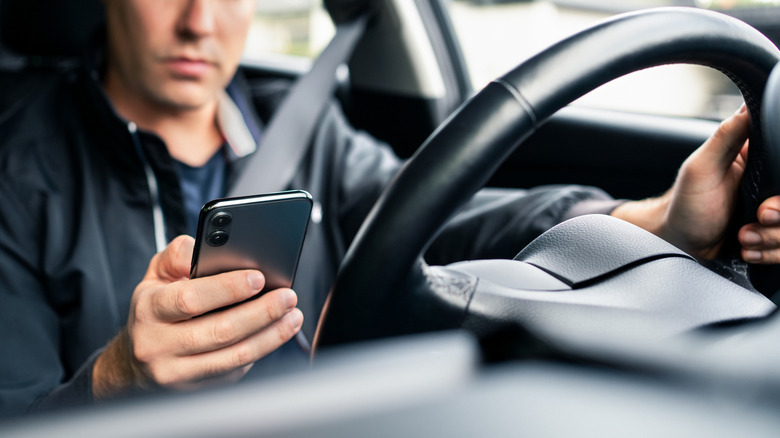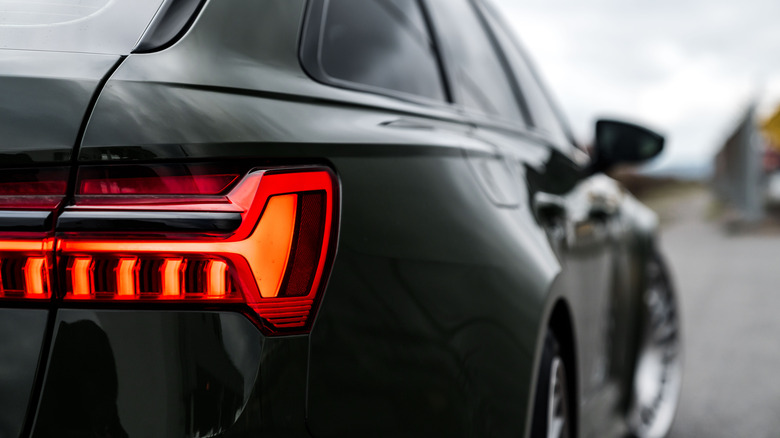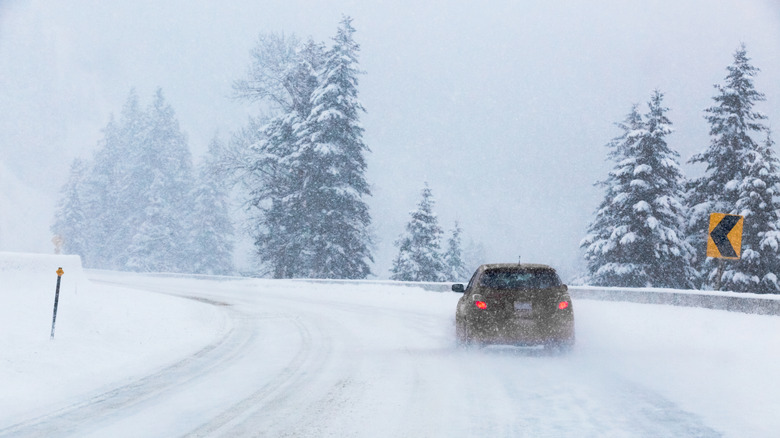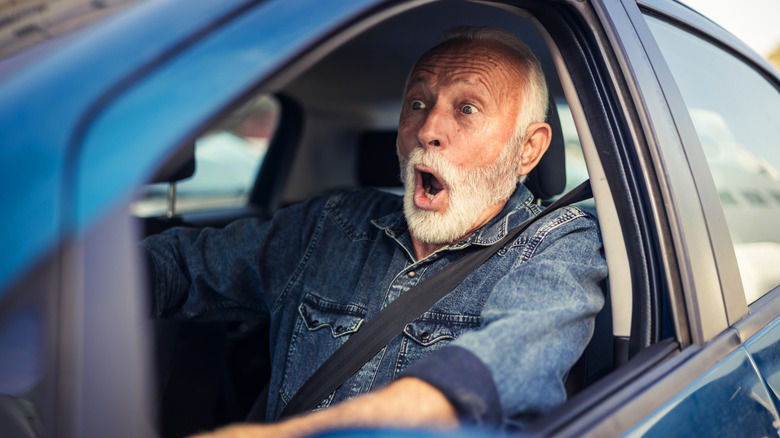5 Common Mistakes That Even Experienced Drivers Make On The Road
The roadways are filled to the brim with drivers of all backgrounds. 94.5% of American residents of driving age (16 and older) drove in 2022, logging an average of 30.1 miles per day across nearly 2.5 discrete trips, according to data from AAA. The average driver spent just over an hour driving every day, racking up some serious collective time behind the wheel. Both experienced and newer drivers share the road with one another, and there's plenty of opportunity for them to showcase their experience levels every time they're in the driver's seat.
Experienced drivers tend to be calmer in traffic and make fewer mistakes like missing turns or incorrectly utilizing a roundabout. However, even the most experienced drivers on the road still tend to fall victim to a laundry list of issues. Numerous simple mistakes can add up to make a long-time driver more dangerous to share the roadway with, but it really doesn't have to be this way. Driving is already dangerous enough, so focusing on these mistakes and working to limit their impact on your driving habits can be a big step in the right direction.
Not only is it a major safety improvement for yourself, but eliminating these sore spots from your typical driving habits will make the streets safer for motorcyclists (a segment of the driving population that's particularly vulnerable), pedestrians, and of course, drivers of other cars. These common mistakes are easy to avoid, but unfortunately even easier to slide into.
Distracted driving
Distracted driving is probably the easiest trap to fall into, regardless of how much experience you have. It only takes a quick glance away from the road to lose focus and inattentively travel tens or even hundreds of feet. The same outcome can happen when experiencing highway hypnosis. Looking down when your phone buzzes or even reaching to grab something you've dropped can make the difference between continued safe travel and crashing. Changes can happen in a split second, and keeping your eyes on the road is just as important for reacting to something surprising like debris falling off the back of a truck, as it is for navigating the curves and bends of the road, and accounting for the line of cars slowing down up ahead.
All manner of distractions can affect your driving. The NHTSA found that in 2023 there were 660,000 drivers on American roads using cell phones or other electronic devices at any given daytime moment. The federal body also calculated a death toll of 3,275 lives as a direct result of incidents related to distracted driving. This can actually plague experienced drivers more prominently, too. Younger and newer drivers may be particularly focused on the task at hand because they are less comfortable driving. Alternatively, experienced drivers may not see an issue with quickly grabbing their phone to check a text because they reckon their skill will keep them travelling in the right direction. It will, only until it won't.
Failing to use turn signals
It's probably safe to assume that every single driver traveling along American roadways today has at one time or another failed to use their turn signal appropriately. Signaling your intention to maneuver in a parking lot or around the neighborhood you call home can feel redundant. You may head off for your morning commute before the sun rises, for instance. Without many other drivers on the road, it's easy to decide signaling isn't necessary. The same can be said for many other instances in which you find yourself driving alone. That feeling of redundancy can lead to a level of complacency that only grows over time.
However, driving is all about adaptability and handling situations as they arise. Just because you're the only driver on the road right now doesn't mean that someone else can't enter the road behind you or pull out right in front of you without warning. There are also pedestrians and cyclists to think about, both of which are far less visible, especially in low light conditions or when drivers feel that they are alone. Failing to signal ahead of a turn is a great way to end up in a collision. Your turn signal not only indicates where you plan to go, but it also telegraphs an intention to slow down ahead of a maneuver. Signaling also indicates your intended directional travel to pedestrians who likely see you but may be invisible from your vantage point.
Speeding
Speeding changes the safety considerations made by a driver significantly. 89% of American drivers speed, and according to AAA surveys less than half of American drivers think that going 15 or more over the speed limit on the highway is either "extremely" or "very" dangerous. Speeding can take on many forms, and it's not always — or perhaps even usually — a practice that involves reckless navigation.
Whether you're going 40 miles over the speed limit or surpassing the posted cap by 2 mph, speeding can result in some unique and unintended consequences. When you travel at higher speeds, you have less time to react to changes in roadway conditions. If someone up ahead stops suddenly, you'll not only need more time slowing down at a greater speed, but you'll have less available time to decide to brake in the first place. At faster speeds, drivers also have less control over their vehicle and the likelihood of totally losing control and crashing or losing traction around a corner increases as well.
The NHTSA reports that speeding resulted in the deaths of 11,775 people in 2023. Every driver can make this mistake, regardless of experience. Everyone wants to get where they're going faster, and experienced drivers may even be more likely to assume they can control their car at higher speeds. The data suggests otherwise. Speeding reduces control and increases risk for all drivers.
Assuming experience translates into better general control in difficult conditions
Everyone with even a moderate level of driving experience has been out in the rain or experienced other inclement weather conditions while behind the wheel. There's no avoiding bad weather entirely, and your daily commute will often come face to face with less than ideal conditions on a regular basis. EV owners will be keenly aware of how cold weather impacts their driving, and all car owners must stay on top of issues like hydroplaning.
Bad weather isn't just an inconvenience, and experienced drivers can easily be lulled into a false sense of security when navigating in high winds, strong rain, or any other kind of troublesome conditions. You might frequently drive in the rain, ultimately trusting in your ability to judge the roadways with too much force. In wet conditions, you'll need as much as twice the stopping distance compared to a dry road. Rain can also hinder your visibility significantly, leading to problems in clear decision making and limit your ability to notice others. Wind is another issue that can be unpredictable. Strong winds can kick up without any notice during a storm, blowing your vehicle out of its lane (and potentially making you drive "left of center") or temporarily limiting your control over the vehicle more broadly.
Accelerating and braking too aggressively
It's frequently tempting to speed, and moving rapidly around traffic buildup on your commute is often something that drivers seek to prioritize. No one wants to sit in traffic, but the impatience that comes from this slowdown can lead drivers to fall into a different kind of driving mistake. When you've been sitting at a light for a while, it's often easy to slam on the gas pedal when the light turns green in the hopes of making it through the intersection on that cycle. Fast, aggressive acceleration is often met with equally jerky braking habits when you inevitably catch up to the car right in front of you. Quick changes in speed like this place added, unnecessary strain on your vehicle. Heavy, aggressive braking is also a bad driving habit that can ultimately waste your money. You'll wear out the sensitive components in your engine and braking systems faster by stomping on your pedals, leading to more frequent trips to the mechanic for repairs. Aggressive driving also uses up gas faster.
Beyond the hit your wallet will take, it's also natural that aggressive driving is dangerous for you and those around you in the moment, too. Braking suddenly adds a bit of uncertainty to the shared roadway that you and others are driving on, making those around you have to pay more careful attention to your car. Similarly, a distracted driver behind you might not notice that you've suddenly slammed the brakes, leading to a potential accident.





